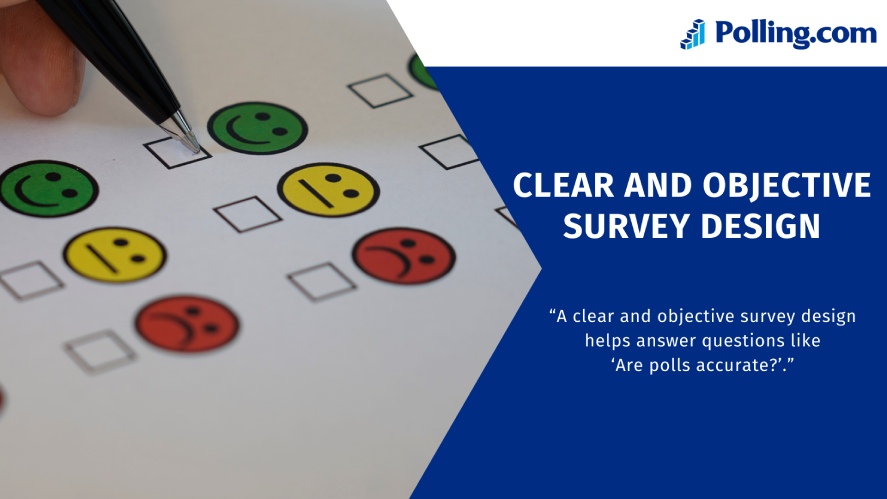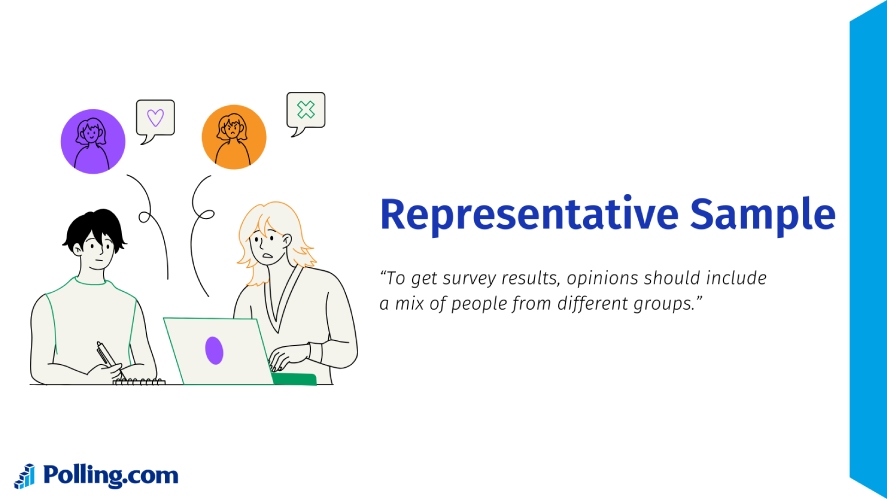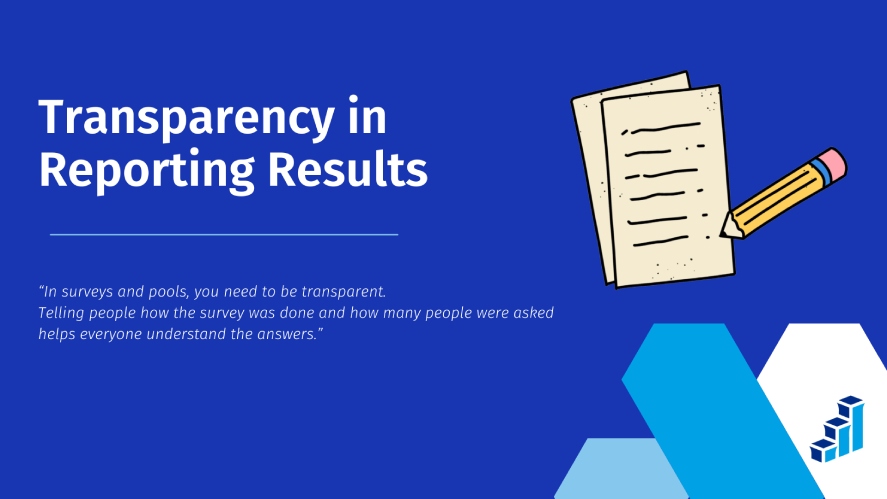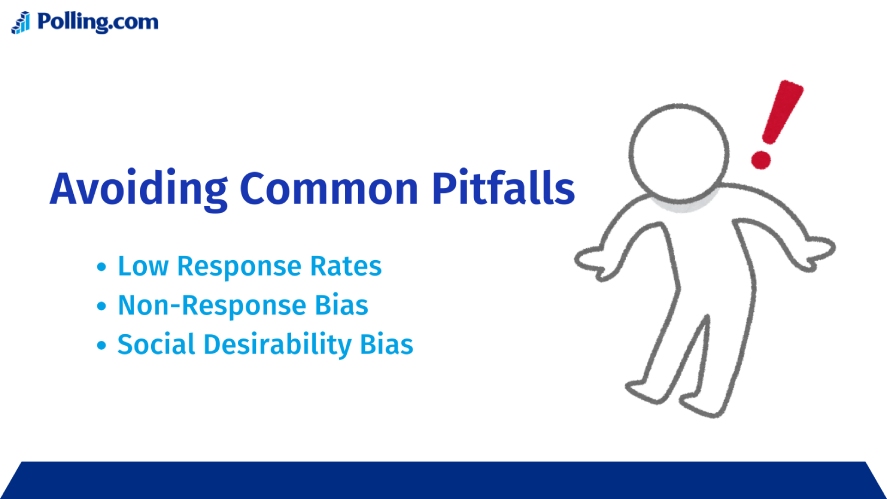
Poll Credibility: Can Surveys Be Reliable?
Credibility is how much people feel they can rely on someone or something.
Similarly, the high credibility of polling will make people believe it gives true and correct information, which is essential for decision-making, research, and data analysis.
So, do you know how accurate are election polls in predicting the election results? Can surveys be reliable?
Until now, many companies, leaders, and researchers have used very highly credible surveys. Due to this, they can choose better products, mayors, and studies.
Knowing that, Polling.com is a platform that prioritizes credibility. It ensures accurate insights so businesses can trust the results to make smart decisions.
Clear and Objective Survey Design
A clear and objective survey design helps answer questions like ‘Are polls accurate?’.
To ensure a survey’s trustworthiness, set clear goals, avoid biased questions, and keep the survey organized.

Well-defined Objectives
When creating a poll or survey, it’s essential to set a clear goal to guide your survey development.
This means you should know precisely what you’re trying to discover about your customers. If you’re unclear about the goal, people might get confused about why they’re being asked these questions.
Plus, when the purpose is clear, it shows that the survey is well-planned and trustworthy.
As a result, the decision-makers will be more likely to believe the results because of that.
This is also true, as having a clear goal can also assist you in asking the right questions that provide better answers.
For instance, if you want to know how students feel about school lunches, you’ll ask questions about food and not random things like favorite sports.
Avoiding Bias in Questions
Remember that when you create a poll, asking questions without bias is essential for gathering reliable answers.
Leading or loaded questions can change how people answer, making results inaccurate.
A leading question is a type of question that guides or steers the person being asked toward a particular answer rather than letting them respond freely with their thoughts.
When you phrase it in a way that encourages a positive response, like asking how fascinating it is that a single question can spark so many different perspectives, you naturally lead people to respond positively.
This makes it hard to get accurate answers.
Next, a loaded question includes assumptions, which might make the answer unfair.
As an example, asking why your customer prefers this character more than others implies that you assume that the person likes this character more, and that may not be true.
To prevent this, it’s essential to ask neutral questions. Neutral questions don’t lead or assume; they just ask directly.
For example, a biased question could be, “Isn’t the new game awesome?” while a neutral one would be, “How would you assess the new game?”.
By asking neutral questions, we get honest answers that better reflect what people actually think.
Structured Survey Flow
It’s essential to ask questions in good order in a survey because it helps people stay focused and makes it easier to answer.
If the questions are mixed up, it can confuse them, and they might not know what to answer.
Just imagine when you ask what they like to do and then suddenly ask how old they are; it feels strange!
It’s better to start with easy questions and then ask harder ones so it’s easier to follow.
When the questions are in good order, people can concentrate and not get tired or bored.
So, ensure the survey questions flow well, and your customers will be happy to finish it.
Representative Sample
For accurate survey results, opinions should include a mix of people from different groups.
Due to that, you can ensure the results truly reflect the views of the whole population.

Importance of Random Sampling
Random sampling is when you choose people from an extensive group so everyone has the same chance to be picked.
To find out what kind of lunch students like, you could randomly select students from each class. This ensures no one is left out, and everyone has a fair chance to be in the survey.
So, random sampling is necessary because it ensures all segments of the target population are included.
If you only pick a few people from one class, it might not show what the whole school thinks. But if you choose people from different classes, you get a better idea of what everyone likes.
In addition, you need a diverse sample, which can make the results more believable and show that they are not limited to just one type of sample.
When you ask different kinds of people, like boys and girls or kids from various grades, the results are more fair.
Thanks to that, businesses can trust the survey, knowing it is true for everyone, not just one group.
Sample Size Considerations
Sample size is vital in surveys because it helps us know how accurate the results are.
When we have a large sample size (asking many people), the results are closer to what the whole group thinks.
Because of this, the chance of making a mistake is lower, which means the results can be trusted more and are likely to be more accurate.
For example, if we only ask 10 people out of 1,000 in a town, the results might not show what most people think.
But if we ask 800 people, we’re more likely to get an answer that matches what the whole town thinks.
So, a small sample size has a considerable margin of error, so it’s less accurate. After all, a large sample size gives us better, more trustworthy results.
Demographic Representation
Demographic representation is crucial because it helps ensure that a study or survey shows what everyone thinks.
A demographic representation includes people of all genders, ages, and ethnicities.
A study that only asks young people may not reveal the opinions or thoughts of older individuals. If it only asks people from one group, it might miss the views of others.
Thus, when we include all kinds of people, the results are fairer and more accurate for everyone.
Reliable Survey Administration Methods
There are many different methods and approaches you can use to give surveys to customers.
Some surveys are online, some are on the phone, and others are in person.
Firstly, online surveys are easy because people can complete them on their computers or phones.
Though online surveys are fast and easy to send, they might not always be reliable.
Some older adults don’t know how to access the internet, and others might not take the time to do the types of survey questions carefully.

However, if you get a lot of responses from different people, the results can still be pretty good.
Next, phone surveys can be more reliable because people talk directly to someone, so they might give better answers.
But it can also depend on the person calling—if they are not transparent or polite, people might stop answering or give wrong information.
Also, not everyone answers phone calls, so you might miss some people.
Finally, in-person surveys can be very reliable because the person asking the questions can explain things if someone doesn’t understand.
Alternatively, it can be hard to reach many people, and some might not feel comfortable talking face-to-face, affecting the results.
In addition, when you send out a survey, the time you pick to send it can have a significant impact on your results.
If you ask people to take a survey during a holiday or a big event, they might be too busy to answer.
It’s better to choose a time when people are free, like during the week when nothing significant is happening.
Additionally, you must leave the survey open for the right time to ensure enough data is collected.
If you keep it open too short, you might not get enough answers. But if you leave it open too long, people might forget about it.
The best time to keep a survey open is usually around one to two weeks, so you can get enough answers without waiting too long.
Transparency in Reporting Results
In surveys and polls, you need to be transparent.
Telling people how the survey was done and how many were asked helps everyone understand the answers.

Clear Methodology Disclosure
To make your survey reliable, you must be transparent by explaining how you did it.
You should tell how you got the answers, how many people took part, and what kind of people answered the survey.
Being transparent helps others easily trust your results because they know how the survey was done.
You can say who took part, like their age, gender, or where they live.
So, the more you explain, the more people trust your results.
Margin of Error & Confidence Levels
The margin of error and confidence level help us understand how good a survey’s results are.
Firstly, the margin of error shows us how much the results of the survey could potentially be incorrect or different from the actual values.
To illustrate, a survey says 60% of people like chocolate with a ±3% margin. The actual number could be between 57% and 63%.
Secondly, the confidence level tells us how sure we are about the survey results.
A 95% confidence level means that 95 out of 100 times, the results would be close to the truth.
Just imagine one survey has a ±3% margin and says 50% like pizza. The actual answer is probably between 47% and 53%.
This is a small range, so we can be more confident that the survey result is close to the truth.
But if the margin is ±10%, the real answer could be anywhere from 40% to 60%.
In this case, it has a much more extensive range, so the survey result is less particular.
Displaying Raw Data
Showing raw data allows others to verify findings, which is essential for evaluating how accurate are polls and surveys.
Raw data is the original information you collect, like numbers or facts, before you analyze or change them.
By showing this data, other people can check your survey and see if your results are correct.
It’s like giving someone the recipe ingredients so they can make the dish themselves.
If they see that everything adds up, they will trust that the results are accurate. This makes your findings more reliable and convincing.
Avoiding Common Pitfalls
To ensure the reliability of survey results, be aware of and avoid common mistakes that can affect the accuracy of the data.
Here are some common pitfalls when it comes to survey design best practices.

Low Response Rates
When very few people answer a survey, it can make the results less reliable.
If not enough people answer, it might not show an accurate picture of what everyone thinks or feels.
To get more people to answer, you can offer rewards, like gift cards, or send personal invitations asking them to join.
Non-Response Bias
Sometimes, some specific groups of people may not respond to the survey or may not participate in it at all.
This can create bias, meaning the results may not reflect the views of everyone.
An example of this is when only young people reply; it might not reflect the opinions of older people.
To avoid this, you can try to reach out to different groups or use methods like reminders to encourage more people to respond.
Social Desirability Bias
Social desirability bias happens when people answer in a way that they think is more socially acceptable instead of being honest.
This is especially problematic when asking about sensitive topics like politics or personal habits.
To fix this, surveys can be made anonymous so people feel safe to give honest answers.
You can also ask questions in a way that doesn’t directly ask for a “right” or “wrong” answer.
Conclusion
In conclusion, when starting a poll or survey, you must ensure it’s trustworthy.
First, the survey needs to be transparent and objective so that the results are accurate. Then, you should ask enough people from different groups.
It’s also important to know how you ask people, whether online or by phone.
Lastly, the answers should be transparency in the results report. Remember that good data is essential for making choices in both business and politics.
If you need a good survey, explore more on Polling.com. We always prioritize correct and reliable data!
